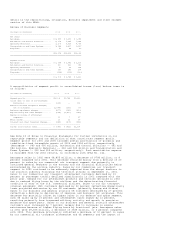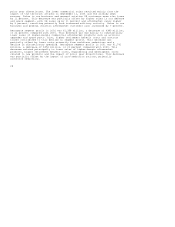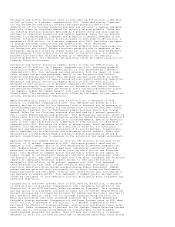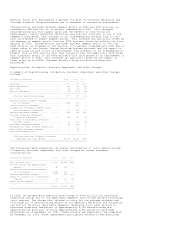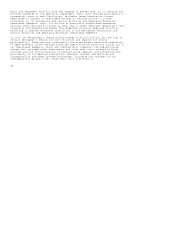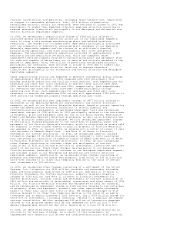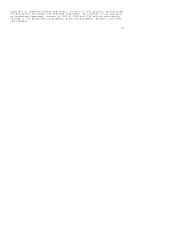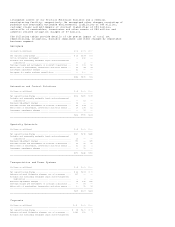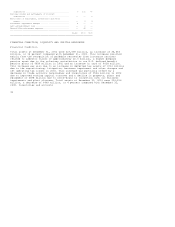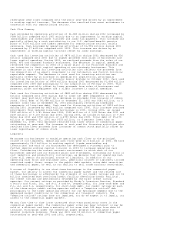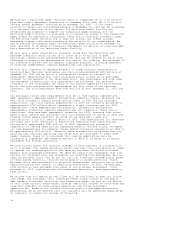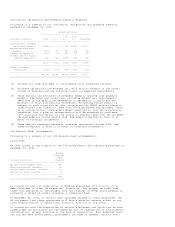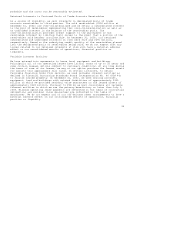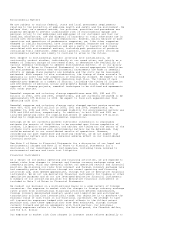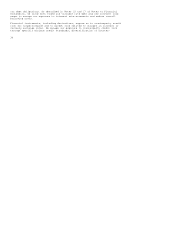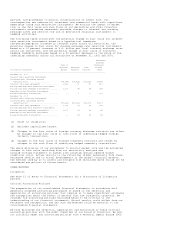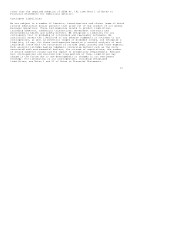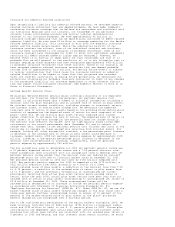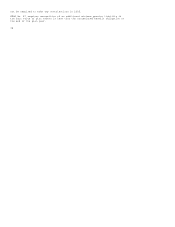Honeywell 2002 Annual Report Download - page 219
Download and view the complete annual report
Please find page 219 of the 2002 Honeywell annual report below. You can navigate through the pages in the report by either clicking on the pages listed below, or by using the keyword search tool below to find specific information within the annual report.receivable were lower compared with the prior year-end driven by an improvement
in working capital turnover. The decrease also resulted from asset writedowns in
connection with our repositioning actions.
Cash Flow Summary
Cash provided by operating activities of $2,380 million during 2002 increased by
$384 million compared with 2001 mainly due to an improvement in working capital
(receivables and inventories) turnover and lower tax payments. This increase was
partially offset by a cash contribution to our U.S. defined benefit pension
plans of $130 million and higher spending for repositioning actions, mainly
severance. Cash provided by operating activities of $1,996 million during 2001
increased by $7 million compared with 2000. This increase was driven by an
improvement in working capital turnover offset by lower earnings.
Cash used for investing activities of $870 million during 2002 decreased by $36
million compared with 2001 due to higher proceeds from sales of businesses and
lower capital spending. During 2002, we realized proceeds from the sales of our
BCVS, PFC and Consumer Products businesses. The decrease in capital spending
reflected the completion in 2002 of a major plant in our Fluorines business and
our intention to limit capital spending at non-strategic businesses. This
decrease in cash used for investing activities also reflects the proceeds from
the disposition of an equity investment in our Automation and Control Solutions
reportable segment. The decrease in cash used for investing activities was
partially offset by an increase in spending for acquisitions, principally
reflecting the acquisition of Invensys Sensor Systems in October 2002. Cash used
for investing activities of $906 million during 2001 decreased by $1,808 million
compared with 2000 due principally to our acquisition of Pittway in 2000. This
decrease was partially offset by lower proceeds from sales of businesses and
property, plant and equipment and a slight increase in capital spending.
Cash used for financing activities of $882 million during 2002 decreased by $11
million compared with 2001 mainly due to lower net debt repayments in the
current year partially offset by a decrease in proceeds from issuance of common
stock. Total debt of $5,089 million at December 31, 2002 was $181 million, or 3
percent lower than at December 31, 2001 principally reflecting scheduled
repayments of long-term debt. Cash used for financing activities of $893 million
during 2001 increased by $823 million compared with 2000. This increase resulted
principally from reduced long-term borrowings in 2001. During 2001, we issued
$500 million of 5 1/8% Notes due 2006, $500 million of 6 1/8% Notes due 2011 and
$247 million of 5.25% Notes due 2006. During 2000, we issued $1 billion of 7.50%
Notes due 2010 and $750 million of 6.875% Notes due 2005. Total debt of $5,270
million at December 31, 2001 was $353 million, or 6 percent lower than at
December 31, 2000. This decrease resulted from lower levels of commercial paper
outstanding at year-end. The increase in cash used for financing activities also
resulted from lower proceeds from issuances of common stock partially offset by
lower repurchases of common stock.
Liquidity
We manage our businesses to maximize operating cash flows as the principal
source of our liquidity. Operating cash flows were $2.4 billion in 2002. We have
approximately $6.0 billion in working capital (trade receivables and
inventories) and each of our businesses has developed a strategic plan to
further improve working capital turnover in 2003 to increase operating cash
flows. Considering the current economic environment in which each of our
businesses operate and our business plans and strategies, including our focus on
cost reduction and productivity initiatives, we believe that our operating cash
flows will remain our principal source of liquidity. In addition to our
operating cash flows and available cash, additional sources of liquidity include
committed credit lines, access to the public debt markets using debt securities
and commercial paper, as well as our ability to sell trade accounts receivables.
A source of liquidity is our short-term borrowings in the commercial paper
market. Our ability to access the commercial paper market and the related cost
of these borrowings is affected by the strength of our credit ratings and our $2
billion committed bank revolving credit facility (Revolving Credit Facility).
Our credit ratings are periodically reviewed by the major credit rating
agencies. Our current ratings as provided by Moody's Investors Service, Standard
& Poor's and Fitch, Inc. are A-2, A and A+, respectively, for long-term debt and
P-1, A-1 and F-1, respectively, for short-term debt. Our credit ratings by each
of the three major credit rating agencies reflect a "negative outlook" due
principally to the lower operating results for our Aerospace segment due to the
depressed market conditions in the commercial air transport industry. The
"negative outlook" ratings have not impaired, nor do we expect it to impair, our
access to the commercial paper markets.
We may from time to time issue unsecured short-term promissory notes in the
commercial paper market. The commercial paper notes may bear interest or may be
sold at a discount and have a maturity of not more than 364 days from date of
issuance. Borrowings under the commercial paper program are available for
general corporate purposes. There was $201 and $3 million of commercial paper
outstanding at year-end 2002 and 2001, respectively.


